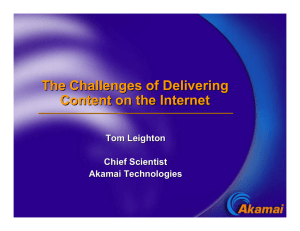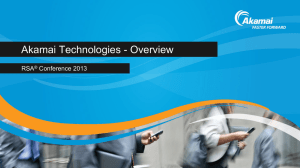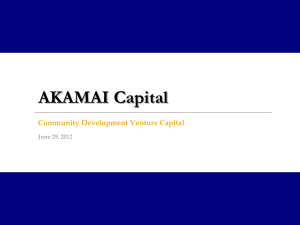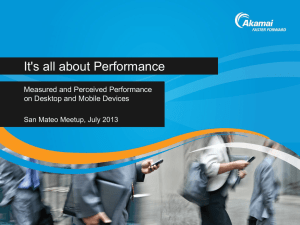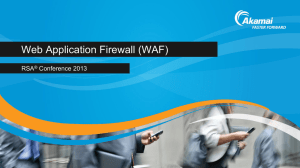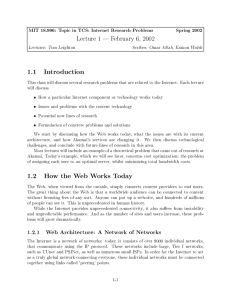lect1
advertisement
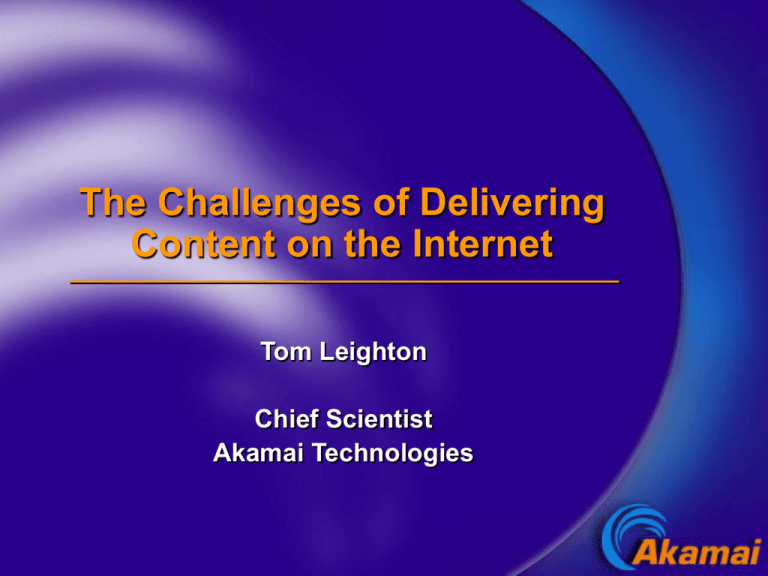
The Challenges of Delivering Content on the Internet Tom Leighton Chief Scientist Akamai Technologies Outline How the Web Works Akamai’s Services Technology Overview Technological Challenges The Future The Web: Simple on the Outside… Content Providers End Users Internet …But Problematic on the Inside Content Providers Peering Points NAP Network Providers UUNet Qwest NAP AOL End Users The First Mile Bottleneck • Content Provider now has worldwide audience; centralization doesn’t work 400 million potential users = huge infrastructure problem The Problems with Peering • The Internet consists of over 7000 networks • No single network controls a large % of access traffic—biggest has 6% share 6% Worldcom % of Network Traffic ISPs (7,000) The Problems with Peering (cont.) • Economic considerations limit peering capacity— results in loss of routes and congestion • Routing algorithms (BGP) ignore congestion! • Routing algorithms are also subject to accidental loss of routes (or introduction of incorrect routes) Bottleneck Implications • Slow downloads - Content must traverse multiple backbones and long distances • Unreliable performance - Content may be blocked by congestion or backbone peering problems • Not scalable - Usage limited by bandwidth available at master site • Inferior streaming quality - Packet loss, congestion, and narrow pipes degrade stream quality • Broadband doesn’t help - As broadband becomes ubiquitous, the disaster of centralized solutions becomes more obvious— not better Outline How the Web Works Akamai’s Services Technology Overview Technological Challenges The Future The Akamai Solution Content Providers Akamai Servers at Network Edge NAP NAP End Users Akamai’s Network Deployment 13,500+ Servers 1000+ Leading Carriers Hosting, Access, Backbones, Satellite & Broadband 60+ Countries Thousands of Websites Are Akamaized Advantages • Fast - Content is served from locations near to end users • Reliable - No single point of failure - Automatic failover • Scalable - Master site no longer requires massive available bandwidth Web object delivered by Akamai Web object delivered without Akamai Noon May 27 Noon May 26 Noon May 25 Noon May 24 Noon May 23 Noon May 22 Noon May 21 Noon May 20 Noon May 19 Noon May 18 Noon May 17 Noon May 16 Noon May 15 Keynote Results Web Site Performance Typical Improvement with Akamai Akamai’s Service Offerings • FreeFlow: delivers objects (gifs, jpgs, etc.) and rich graphics to end users from the edge of the Internet • FreeFlow Streaming: delivers streaming content to viewers worldwide with dramatic improvements in quality and reliability • Akamai Conference: a reseller offering that uses streaming media to extend the reach and functionality of ordinary conference calls • Akamai Forum: enables businesses to produce live, interactive Webcasts Akamai Forum No special client software Live or On-Demand Streaming Video Speaker Support e.g. PowerPoint Other Features: • Ask a Question • Live Audience Phone-in • Viewer Registration • E-mail promotion • Download Slides • Searchable Content Dynamic Surveys & Profiling Indexed Program Schedule Akamai’s Service Offerings • FirstPoint: a global traffic management service for content providers with geographically distributed Web servers • EdgeScape: allows customization of content based on user’s geographic location and connection bandwidth • Reporter and Traffic Analyzer: provide historical and real-time Web site usage data Reporter and Traffic Analyzer Reporter: • For viewing of historical logs • Customized data-mining of customer traffic Traffic Analyzer: • Real-time viewing of customer traffic • Reports geographic distribution of traffic Akamai’s Service Offerings • ACS: storage management service that persistently stores content delivered to end users via Akamai’s network • Digital Parcel Service: a comprehensive digital distribution and rights management solution • EdgeSuite: enables dynamic assembly of personalized content at Akamai’s edge servers Outline How the Web Works Akamai’ Services Technology Overview Technological Challenges The Future Downloading www.xyz.com — The Old Way DNS 1 WWW.XYZ.COM Customer Web Server 2 10.10.123.8 5 3 4 6 • User enters www.xyz.com • Browser requests IP address for www.xyz.com • DNS returns IP address • Browser requests HTML • Customer Web server returns HTML 7 10.10.123.8 • Browser obtains IP address for domain of embedded objects for page • Browser requests embedded objects • Customer’s Web server returns embedded objects Finding the IP Address for www.xyz.com — The Old Way .net Root (InterNIC) 4 5 TTL: 1 Day Local Name Server 6 7 TTL: 30 Minutes 10 8 3 1 2 Browser’s Cache 9 OS xyz.com DNS Servers Downloading www.xyz.com with Akamai’s EdgeSuite Customer Web server WWW.XYZ.COM DNS 1 2 6 5 7 3 • User enters www.xyz.com • Browser requests IP address for www.xyz.com • DNS returns IP address of optimal Akamai server • Browser requests HTML • Akamai server assembles page, contacting customer Web server if necessary 4 • Optimal Akamai server returns Akamaized HTML • Browser obtains IP address of optimal Akamai servers for embedded objects • Browser obtains objects from optimal Akamai servers Key Components • DNS Resolution: Finding the IP address for www.xyz.com • Page Assembly • Connecting from the edge to the source Finding the IP Address: The Akamai Way 4 xyz.com xyz.com’s nameserver akamai.net 8 a212.g.akamai.net 7 6 .net Root (InterNIC) 5 10.10.123.5 9 15.15.125.6 www.xyz.com 10 g.akamai.net 11 20.20.123.55 12 Local Name Server End User 16 Browser’s Cache 14 3 1 2 15 OS Akamai High-Level DNS Servers a212.g.akamai.net 30.30.123.5 13 Akamai Low-Level DNS Servers DNS Maps & Time-To-Live • Maps created using info on: - Internet congestion System loads User demands Server status • Maps are constantly recalculated: - Every few minutes for HLDNS - Every few seconds for LLDNS Time To Live 1 day Root 30 min. HLDNS 30 sec. LLDNS TTL of DNS responses gets shorter further down the hierarchy Page Assembly Container Page [TTL=5d] [TTL=8h] [XYZ news, content, promotions, etc. TTL=5d] [TTL=15m] [Breaking headlines TTL=2h] Site owners create container pages that can be populated with varying content Page Assembly If gender = male and geography = New York then show article on NY Giants Sportswear [TTL=8h] [XYZ news, content, promotions, etc. TTL=5d] [TTL=15m] [Breaking headlines TTL=2h] EdgeSuite enables Web sites to build and deliver customized content at the edge Syntax Example • Similar to SSI so it’s easily understood— but also breaks performance bottlenecks when distributed across 12,000 servers • Used as an API to third-party applications on Akamai’s network <html> <asi version = “1.0”> <head><title>Akamai Weather Forecast </title></head> <asi if= ”$geo == dc” include=”dcwthr.htm”/> <asi else-if= ”$geo == boston” include=”bostonwthr.htm”/> <asi else if = ”$geo == nyc “ include= “nycwthr.htm”/> <asi else == “ “ include= “uswthr.htm”/> </asi> </html> Connecting from the Edge to the Source End User Source Server Connecting from the Edge to the Source End User X Source Server • Maintain path performance data so that the optimal path can be used to reach optimal customer location (Akarouting) Connecting from the Edge to the Source End User Akamai ACS X Source Server • Maintain path performance data so that the optimal path can be used to reach optimal customer location • If site is unreachable, then retrieve authoritative default information from Akamai’s ACS service Differences for Live Streaming 1 x 2 3 4 Satellite Downlink Satellite Uplink 1 2 3 4 1 2 3 4 Encoding Entry Point 1 X 2 X 3 X 4 X x1 2 3 4 Top-level reflectors Regions Outline How the Web Works Akamai’s Services Technology Overview Technological Challenges The Future Technological Challenges 1) Mapping and Server Assignment • Huge scale - Hundreds of millions of users - Tens of thousands of servers - Thousands of locations - Thousands of customers • Must monitor Internet conditions & instantly respond to changes - Internet congestion and failures are widespread and unpredictable • Must load balance widely varying kinds of traffic, optimize multiple kinds of resources, and minimize various costs • Must tolerate large numbers of component failures without ever disrupting service • Control algorithms must be distributed and work with imperfect information • DNS responses must be given in milliseconds Technological Challenges 2) Logging, Reporting, and Billing • Several billion hits per day and growing rapidly • Real-time reporting of data to customers with user profiling and customized data mining • Real-time monitoring of system for NOCC with meaningful alerts and performance metrics • Support for real-time SQL queries to the system Technological Challenges 3) Operations • Huge distributed network that cannot go down, despite frequent software changes and constant growth • System needs to be secure against attacks as well as buggy third-party software Technological Challenges 4) Content Freshness and Accuracy • Stale content can never be served • Fast correction procedures in case of customer errors • Allow flexibility and ease of customer control over content Technological Challenges 5) Management of Live Streaming and Webcasting • Information dispersal to handle packet loss • Automatic swapping on connections to improve performance • Support for interactive and personalized messaging; e.g., Q&A • Real-time data aggregation for polling, etc. • Synchronized delivery of audio, video, and slides Outline How the Web Works Akamai’s Services Technology Overview Technological Challenges The Future BET.com The Premier African-American Portal “On Monday our traffic doubled, so we added two new servers with no effect. Tuesday afternoon we called Akamai. Tuesday night we were Akamaized and instantly 6-10 times faster.” Craig Maccubbin CTO of BET.com BET.com Akamaized 90% of Each Web Page with FreeFlow: • Improved site performance (6-10 times) • Quadrupled page view capacity • Postponed 2nd data center build out • Preserved graphic-rich page design • Improved user experience • Net first year benefits of $1.3 million Questions?

